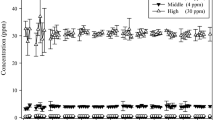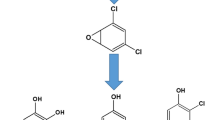Abstract
Inhalation exposure to toluene diisocyanate (TDI) can result in a variety of airway diseases. Concern has been expressed that a putative carcinogenic potential of TDI exists as a result of the formation of toluenediamine (TDA) by hydrolysis of the isocyanate in the body. Results from long-term bioassays (TDI inhalation versus gavage in rats and mice) are contradictory and discrepancies do exist concerning the interpretation of adverse effects. This study was performed to analyze the distribution and reactivity of radioactively-labeled TDI using vapor exposure in a rat model system. Rats were exposed to 14C-TDI vapors at concentrations ranging from 0.026 to 0.821 ppm for 4h. All tissues examined showed detectable quantities of radioactivity, with the airways, gastrointestinal system and blood having the highest levels which increased with exposure concentration. The concentration of radioactivity in the bloodstream after exposure was linear with respect to dose. The majority (74–87%) of the label associated with the blood was recovered in the plasma, and of this, 97–100% of the 14C existed in the form of biomolecular conjugates. Analysis of stomach contents shows that the majority of the label is also associated with high (>10 kDa) molecular weight species. While a larger percentage (28%) of the label is found in the low molecular weight fraction relative to blood, this low molecular weight labeled material represents at least eight different components. Thus, over the vapor exposure concentrations and time tested, it appears that conjugation is the predominant reaction and that free TDA is not a primary in vivo reaction product under the conditions tested.
Similar content being viewed by others
References
Altman PL, Dittmer DS (1971) Handbook of respiration and circulation. Federation of American Society for Experimental Biology Bethesda, Md.
Anderson M, Binderup M, Kiel P, Larsen H, Maxila J (1980) Mutagenic action of isocyanates used in the production of polyurethanes. Scand J Work Environ Health 6: 221–226
Brown WE, Green AH, Cedel TE, Cairn J (1987) Biochemistry of protein-isocyanate interactions — a comparison of the effects of aryl vs alkyl isocyanates. Environ Health Perspec 72: 5–11
Czuppon AB, Marczynski B, Baur X (1992) Transiente Änderungen der tertiären Serumproteinstrukturen nach inhalativer Exposition mit Isozyanaten. Atemwegs- und Lungenkrkh 18: 292–293
Dahl AR (1988) Comparative metabolic basis for the disposition and toxic effects of inhaled materials. In: Mohr U (ed) Inhalation toxicology: design and interpretation of inhalation studies and their use in risk assessment. Springer, Berlin Heidelberg New York, pp 41–65
Dieter MP, Matthews HB, Jameson CW, Jeffcoat AR (1990) Comparative metabolism of 2,4- and 2,6-isomers of toluene diisocyanate in F344 rats. Toxicologist 10: 334
Ferguson JS, Kennedy AL, Stock MF, Brown WE, Alarie Y (1988) Uptake and distribution of 14C during and following exposure to [14C]methyl isocyanate. Toxicol Appl Pharmacol 94: 104–117
Hill BH (1986) Biochemical studies on the in vitro target of toluene diisocyanate, Doctoral Dissertation, Carnegie Mellon University, Pittsburgh, Pa. Available from University Microfilms, Ann Arbor, Mich. Publication No. 87-02 890
Jeffcoat AR (1985) Disposition of 2,6-toluene diisocyanate in Fischer 344 rats. In Research Triangle Institute Report to National Institute of Environmental Health Sciences, Report No. RTI/2227/00-06P
Kennedy AL (1990) The in vitro reactivity of inhaled isocyanates: comparative analysis of cellular and macromolecular targets. Doctoral Dissertation, Carnegie Mellon University, Pittsburgh, Pa. Available from University Microfilms, Ann Arbor, Mich., Publication No. 90-33059
Kennedy AL, Brown WE (1992) Isocyanates and lung disease: experimental approaches to molecular mechanisms. Occupational Medicine: State of Art Reviews 7: 301–329
Kennedy AL, Stock MF, Alarie Y, Brown WE (1989) Uptake and distribution of 14C during and following exposure to radioactive toluene diisocyanate. Toxicol Appl Pharmacol 100: 280–292
Kochman S, Lefebvre S, Bernard J, Maujean A, Cazabat A, Lavaud F, Manfait M (1990) Toluene diisocyanate-induced conformational changes of serum albumin: a study on repeated inhalations in guinea pigs. Toxicol Lett 50: 165–171
Laemmli UK (1970) Cleavage of structural proteins during the assembly of the head of bacteriophage T4. Nature 227: 680–685
Loeser E (1983) Long term toxicity and carcinogenicity studies with 2,4/2,6-toluene-diisocyanate (80/20) in rats and mice. Toxicol Lett 15: 71–81
Marcali K (1957) Microdetermination of toluene diisocyanates in atmosphere. Anal Chem 29: 552
National Cancer Institute (1979) Bioassay of 2,4 diaminotoluene for possible carcinogenicity. Carcinogenesis Technical Report Series 162. NIH Pub 79-1718. DHEW, Washington, DC
National Institute for Occupational Safety and Health (1978) Criteria for a recommended standard occupational exposure to diisocyanates. NIH Pub 78-215. DHEW, Washington, DC
Patterson R, Hargreave FE, Grammer LC, Harris KE, Dolovich J (1987) Toluene diisocyanate respiratory reactions: reassessment of the problem. Int Arch Allergy Appl Immunol 84: 93–100
Rosenberg C, Savolainen H (1985) Detection of urine amine metabolites in toluene diisocyanate exposed rats. J Chromatogr 323: 429–433
Saclay (1977) Pharmacokinetics of TDI after inhalation exposure of rats to labeled TDI. Report by Laboratoir d'Etudes du Metabolism des Medicaments to the International Isocyanate Institute, Parsippany, N.J.
Schroeder R, Moore KD (1985) A reverse phase liquid chromatographic determination of hexamethylene diisocyanate in inhalation chamber atmospheres. Mobay Toxicology Report, No. 639.
Skarping G, Brorson T, Sango C (1991) Biological monitoring of isocyanates and related amines. III. Test chamber exposure of humans to toluene diisocyanate (TDI). Int Arch Occup Environ Health 63: 83–88
Stoltz M, Czarnecki D, Little L, Palla F, El-Hawari M (1987) Metabolism and disposition of 14C-labeled toluene diisocyanate (TDI) following oral and inhalation exposure: preliminary studies. Midwest Research Institute (MRI), Kansas City, Mo
Timchalk C, Smith FA, Bartels MJ (1994) Route-dependent comparative metabolism of [14C]-toluene 2,4-diisocyanate and [14C]-toluene 2,4-diamine in Fischer 344 Rats. Toxicol Appl Pharmacol 124: 181–190
Author information
Authors and Affiliations
Rights and permissions
About this article
Cite this article
Kennedy, A.L., Wilson, T.R., Stock, M.F. et al. Distribution and reactivity of inhaled 14C-labeled toluene diisocyanate (TDI) in rats. Arch Toxicol 68, 434–443 (1994). https://doi.org/10.1007/s002040050094
Received:
Accepted:
Issue Date:
DOI: https://doi.org/10.1007/s002040050094




